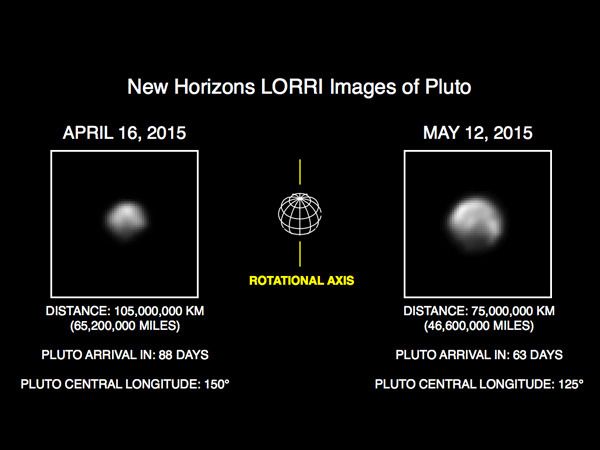
NASA / Johns Hopkins University Applied Physics Laboratory / Southwest Research Institute
New Horizons Sees More Detail as It Draws Closer to Pluto (Press Release)
What a difference 20 million miles makes! Images of Pluto from NASA's New Horizons spacecraft are growing in scale as the spacecraft approaches its mysterious target. The new images, taken May 8-12 using a powerful telescopic camera and downlinked last week, reveal more detail about Pluto's complex and high-contrast surface.
The images were taken from just under 50 million miles (77 million kilometers) away, using the Long-Range Reconnaissance Imager (LORRI) on New Horizons. Because New Horizons was approximately 20 million miles closer to Pluto in mid-May than in mid-April, the new images contain about twice as many pixels on the object as images made in mid-April.
A technique called image deconvolution sharpens the raw, unprocessed pictures beamed back to Earth. In the April images, New Horizons scientists determined that Pluto has broad surface markings – some bright, some dark – including a bright area at one pole that may be a polar cap. The newer imagery released here shows finer details. Deconvolution can occasionally produce spurious details, so the finest details in these images will need confirmation from images to be made from closer range in coming weeks.
"These new images show us that Pluto's differing faces are each distinct; likely hinting at what may be very complex surface geology or variations in surface composition from place to place," said New Horizons Principal Investigator Alan Stern, of the Southwest Research Institute in Boulder, Colorado. "These images also continue to support the hypothesis that Pluto has a polar cap whose extent varies with longitude; we'll be able to make a definitive determination of the polar bright region's iciness when we get compositional spectroscopy of that region in July."
The images New Horizons returns will dramatically improve in coming weeks as the spacecraft speeds closer to its July 14 encounter with the Pluto system, covering about 750,000 miles per day.
"By late June the image resolution will be four times better than the images made May 8-12, and by the time of closest approach, we expect to obtain images with more than 5,000 times the current resolution," said Hal Weaver, the mission's project scientist at the Johns Hopkins University Applied Physics Laboratory (APL) in Laurel, Maryland.
Following a January 2006 launch, New Horizons is currently about 2.95 billion miles from home; the spacecraft is healthy and all systems are operating normally.
APL designed, built, and operates the New Horizons spacecraft, and manages the mission for NASA's Science Mission Directorate. SwRI leads the science team, payload operations and encounter science planning. New Horizons is part of the New Frontiers Program managed by NASA's Marshall Space Flight Center in Huntsville, Alabama.
Source: New Horizons Website
****

NASA / JHU APL / SwRI / Steve Gribben

No comments:
Post a Comment